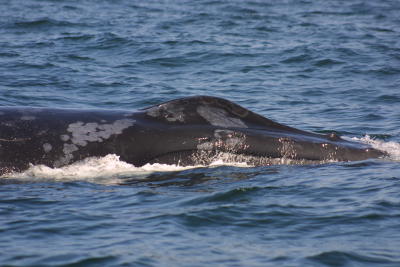River subbasins more depleted than
official figures show
09 April 2024
Published online 22 December 2014
Two new studies reveal more about humpback whales - the Arabia Sea harbors the populations' most isolated and genetically distinct types and these carry a skin disease not previously known to affect them.

© Gianna Minton
The study, by scientists from the Environment Society of Oman, the Wildlife Conservation Society, the American Natural History Museum and others, recommends classifying this population, which was severely reduced by illegal whaling in the 1960s, as “critically endangered” on the IUCN Red List.
A second study, however, carried out by several of the same researchers, has found that the population carries a disease not previously known to affect humpback whales, increasing concerns about its well-being.
The humpbacks of the Arabian Sea have always been uniquely reluctant to migrate, unusual in a species known for travelling up to 25,000 kilometres each year.
To determine how different this population is, the researchers collected tissue samples from 47 whales off the coast of Oman and compared microsatellite markers in their nuclear and mitochondrial DNA with data from the southern hemisphere and North Pacific humpback populations. “The Omani animals are radically different from everything else,” says Tim Collins, a co-author of the study.
Their analysis suggests that the Arabian Sea population diverged from its closest kin in the southern hemisphere around 70,000 years ago. The population’s isolation is compounded by its breeding cycle, which differs from that of the nearest humpback populations near Madagascar and Mozambique. According to the authors, the Arabian Sea population's small size and continued vulnerability merit its reclassification in the IUCN Red List as “critically endangered” rather than “endangered”.
“The recommendation to change the status under IUCN criteria is well supported by the genetic evidence, as well as the history of illegal whaling and the current threats from human activity," says Scott Baker, Associate Director of the Marine Mammal Institute at Oregon State University.
Baker, who has studied populations of humpback whales around the world, is familiar with the issues surrounding the species in the Arabian Sea but was not involved with this study.
As a species, humpbacks have recovered well during the past few decades. Listed as “endangered” in the 1980s, their status improved to “vulnerable” in the 1990s before the IUCN moved them to the “least concern” category in 2008. Nevertheless, Baker argues that conservation efforts should focus on populations rather than species.
“Biodiversity is really protected at the population level, not the species level. Species are critical to maintaining diversity taxonomically speaking, but if you don't have diversity in their distribution, they're no longer a functional component of the ecosystem,” he explains.
Unlike other populations humpbacks in the Arabian Sea have not recovered.
The population is small and their number continues to decline. Illegal whaling allegedly by Soviet operators, was indeed harmful, but does not explain the extent of the damage. Baker says continuing pressures on the population; from obvious factors like coastal development and fishing, and reduced food availability are also to blame.
Further evidence of the population's health issues can be seen in whale identification photos taken off the coast of Oman from 2000 onwards. The images show irregular skin lesions on the whales' flanks and backs resembling those caused by tattoo skin disease, a common ailment of toothed whales which has only rarely been reported in baleen whales and has never been observed in humpbacks or closely related species. Since the cause of the lesions is unknown, the authors have described the condition as “tattoo-like skin disease”.
The researchers are concerned about the high prevalence of this disease in the population and its increase during the period documented by the photos; possibly indicative of underlying health issues and a repressed immune system, perhaps due to anthropogenic stress.
Though it has no direct legal impact, a “critically endangered” status will be helpful in negotiating with local governments and stakeholders in dealing with threats still facing the population, from ship strikes to the expansion of fisheries.
“I would suspect something like 60% of Arabian Sea humpbacks have some indication of net damage. They've been entangled at some point, they have a rope scar somewhere, or they're missing bits of dorsal fin because they had it rubbed off by a net,” says Collins. To Collins and his colleagues, humpback whales are “the canaries of the northern Indian Ocean” and their status reflects our management of these ecosystems as a whole.
“What's special about these animals is that they're Arabian Sea animals,” says Collins. “They don't occur anywhere else. They're something to be treasured.”
doi:10.1038/nmiddleeast.2014.283
Stay connected: